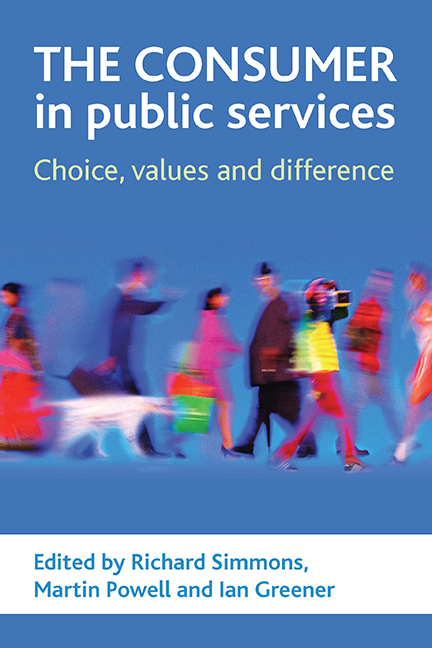Book contents
- Frontmatter
- Contents
- List of figures and tables
- Acknowledgements
- Notes on contributors
- Foreword
- one Introduction: managing the ‘unmanageable consumer’
- two The consumer and New Labour: the consumer as king?
- three Narratives of public service delivery in the UK: comparing central and local government
- four Understanding the ‘differentiated consumer’ in public services
- five Differentiating consumers in professional services: information, empowerment and the emergence of the fragmented consumer
- six The healthcare consumer
- seven The consumer in education
- eight The consumer and social housing
- nine The people’s police? Citizens, consumers and communities
- ten The consumer in social care
- eleven Differentiated consumers? A differentiated view from a service user perspective
- twelve Authoritative consumers or experts by experience? User groups in health and social care
- thirteen The public service consumer as member
- fourteen Conclusion: the consumer in public services
- Index
fourteen - Conclusion: the consumer in public services
Published online by Cambridge University Press: 22 January 2022
- Frontmatter
- Contents
- List of figures and tables
- Acknowledgements
- Notes on contributors
- Foreword
- one Introduction: managing the ‘unmanageable consumer’
- two The consumer and New Labour: the consumer as king?
- three Narratives of public service delivery in the UK: comparing central and local government
- four Understanding the ‘differentiated consumer’ in public services
- five Differentiating consumers in professional services: information, empowerment and the emergence of the fragmented consumer
- six The healthcare consumer
- seven The consumer in education
- eight The consumer and social housing
- nine The people’s police? Citizens, consumers and communities
- ten The consumer in social care
- eleven Differentiated consumers? A differentiated view from a service user perspective
- twelve Authoritative consumers or experts by experience? User groups in health and social care
- thirteen The public service consumer as member
- fourteen Conclusion: the consumer in public services
- Index
Summary
Introduction: choice is ‘not the only fruit’?
A key focus for the contributors to this book was to think about the ‘differentiated consumer’ in public services and what it meant from their perspectives in relation to public services and consumption. Their contributions show that people are working with a wide range of understandings in this regard. In this chapter we will attempt to make sense of this by returning to some of the themes set out in the Introduction. First, we recognise that many different faces and mechanisms of consumerism exist. This helps us to identify who it is that presents themself when they use public services and what their expectations might be, as well as what responses they might face from public service providers. Second, we acknowledge the role of different public service contexts, and that what works in terms of consumerism and choice for some people in some settings may not be universal. Third, we acknowledge the role of values – not only in underpinning difference in consumer faces and mechanisms, but also in how these differences are recognised and applied in different public service contexts.
One of the key aims of the book is to go beyond the ‘consumer as chooser’. In doing so, we have adopted the subtitle ‘Choice, values and difference’, as we believe that each has an important part of the story to tell. Current debates in the public services have often turned on relatively simplistic notions of the consumer as chooser. Choice within public services is variously presented here as a public service ‘good’ or a public service ‘bad’. In relation to this form of consumerism, certain competing values are either brought to the forefront or pushed to the background of debate. For example, Jones (Jones and Needham, 2008) suggests a range of consumer values such as competition, representation, access, choice, information, safety, equity and redress (see also Potter, 1988; Policy Commission on Public Services, 2004). More than 20 years ago Clode et al (1987, p 5) also pointed to the enduring conflict between the fundamental values of liberty and equality (to which we might add the often-forgotten member of that famous trilogy, ‘fraternity’). Unsurprisingly, this conflict has not yet been resolved and continues to underpin a good proportion of the debates about choice (and the consumer as chooser) in public services.
- Type
- Chapter
- Information
- The Consumer in Public ServicesChoice, Values and Difference, pp. 255 - 280Publisher: Bristol University PressPrint publication year: 2009

